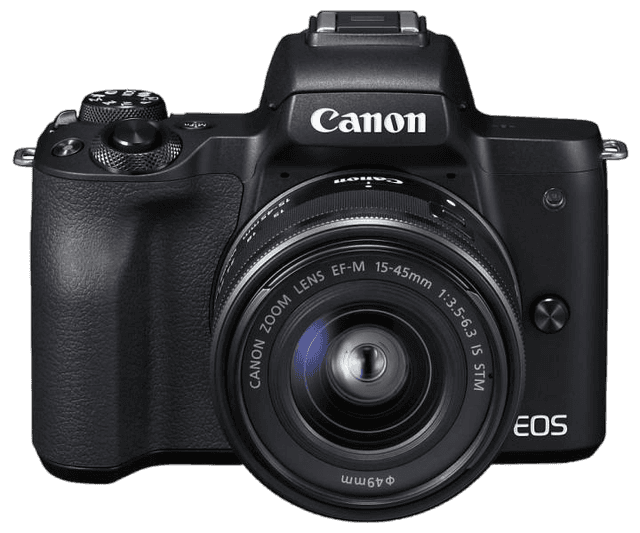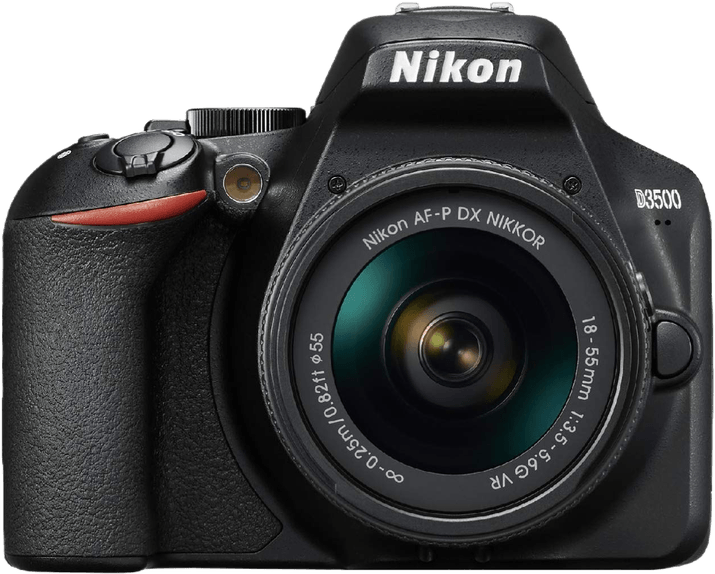Canon EOS M50 vs Nikon D3500 Comparison
Canon EOS M50

Nikon D3500

The Nikon D3500 edges out the Canon EOS M50 with a score of 61/100 compared to the M50’s 59/100. Both cameras were released in 2018, with the M50 being a mirrorless camera and the D3500 a DSLR. They share similar launch prices, with the M50 at $779 and the D3500 at $499.95.
The Canon EOS M50 is lighter, weighing 390g, and has a smaller size of 116 x 88 x 59mm, making it more portable. On the other hand, the Nikon D3500 has a higher score, indicating better overall performance. Despite being heavier at 615g and larger at 124 x 97 x 70mm, the D3500 offers a more affordable option for those looking for a quality camera.
Considering the slight differences in scores and specifications, the Nikon D3500 seems like a better choice for those seeking a balance between performance and affordability. However, the Canon EOS M50 is ideal for users who prioritize portability and a compact design.
Canon EOS M50 vs Nikon D3500 Overview and Optics
The Nikon D3500 outperforms the Canon EOS M50 in optics with a score of 65/100, compared to the Canon’s 59/100. Both cameras share several common specifications, such as 24-megapixel resolution, CMOS sensor type, APS-C sensor size, and the absence of image stabilization. However, there are differences that make the Nikon D3500 a better choice in terms of optics.
The Nikon D3500 has a higher DXOMARK score for its sensor, with 87 compared to the Canon EOS M50’s 58. This means the Nikon D3500 delivers better image quality, with higher dynamic range and better low-light performance. Additionally, the Nikon D3500 features a Nikon F lens mount, which offers a wider variety of compatible lenses than the Canon EOS M50’s EF-M lens mount. This provides more flexibility and options for photographers when choosing lenses for different shooting scenarios.
On the other hand, the Canon EOS M50 has a faster shooting speed of 10 frames per second (fps) compared to the Nikon D3500’s 5 fps. This can be an advantage for capturing fast-moving subjects or action photography. Furthermore, the Canon EOS M50 has a more advanced processor, the Digic 8, while the Nikon D3500 uses the Expeed 4 processor. A more advanced processor could potentially result in faster processing and better image quality.
Despite these advantages of the Canon EOS M50, the Nikon D3500’s superior sensor performance and wider lens compatibility make it the better choice for optics. The Canon EOS M50’s faster shooting speed and advanced processor may be beneficial for specific photography needs, but the Nikon D3500’s overall optics performance is stronger.
Canon EOS M50 vs Nikon D3500 Video Performance
The Canon EOS M50 emerges as the winner in video capabilities with a score of 91/100, while the Nikon D3500 trails behind with a score of 56/100. Both cameras offer different video specifications, and this comparison highlights their similarities and differences in terms of video performance.
Regarding common features, both cameras have the capacity to record high-quality videos. However, the Canon EOS M50 outperforms the Nikon D3500 in several aspects. The EOS M50 offers a maximum video resolution of 4K (3840 x 2160) compared to the D3500’s Full HD (1920 x 1080) resolution. Additionally, the EOS M50 boasts a maximum video frame rate of 120fps, which is twice the 60fps offered by the Nikon D3500. This results in smoother and more detailed footage. Furthermore, the Canon EOS M50 comes with built-in time-lapse functionality, a feature absent in the Nikon D3500.
Despite these advantages, the Nikon D3500 does not have any specific superiority in video capabilities over the Canon EOS M50. The primary difference between the two cameras lies in the video resolution, frame rate, and time-lapse functionality, with the Canon EOS M50 leading in all three aspects.
The comparison of the Canon EOS M50 and Nikon D3500 in terms of video capabilities clearly shows the former as the better choice for those prioritizing video performance. The EOS M50’s 4K resolution, higher frame rate, and built-in time-lapse functionality justify its higher score and make it the superior option for videographers and content creators.
Canon EOS M50 vs Nikon D3500 Features and Benefits
The Canon EOS M50 takes the lead in features with a score of 70 out of 100, while the Nikon D3500 trails behind with a score of 54. Both cameras share a few common features, such as a 3-inch screen size, the absence of GPS, and Bluetooth connectivity. However, the Canon EOS M50 outshines the Nikon D3500 in several aspects.
The EOS M50 boasts a higher screen resolution of 1,040,000 dots, compared to the D3500’s 921,600 dots. This difference ensures clearer and sharper image previews on the EOS M50. Additionally, the EOS M50 has a touchscreen, making it easier for users to navigate through settings and focus points. The flip screen on the EOS M50 is another advantageous feature, allowing photographers to take shots from various angles and assisting in vlogging or selfie-taking.
In contrast, the Nikon D3500 lacks a touchscreen and a flip screen, limiting its flexibility and ease of use. However, the D3500 has an edge over the EOS M50 with its absence of Wi-Fi connectivity. This feature may be beneficial for users who prefer a more straightforward, traditional camera experience without the need for additional wireless connections.
Despite the Nikon D3500’s lower feature score, it still offers a solid camera experience with Bluetooth connectivity and a 3-inch screen. The Canon EOS M50, with its higher feature score, delivers a more versatile and user-friendly experience through its touchscreen, flip screen, and Wi-Fi connectivity. Ultimately, the choice between these two cameras depends on the user’s preferences and priorities in terms of features and functionality.
Canon EOS M50 vs Nikon D3500 Storage and Battery
The Nikon D3500 outperforms the Canon EOS M50 in storage and battery, scoring 48/100 compared to the M50’s 13/100. Both cameras have one memory card slot, accepting SD, SDHC, and SDXC cards. Neither offers USB charging.
The D3500’s superior score stems from its impressive battery life, providing 1550 shots per charge with the EN-EL14a battery. In contrast, the M50’s LP-E12 battery allows for only 235 shots. The longer battery life makes the D3500 more suitable for extended shooting sessions and reduces the need for frequent battery replacements or recharging.
However, the M50 has a slight advantage with its memory card compatibility, as it supports UHS-I cards, enabling faster data transfer. The D3500 does not have this feature.
In terms of storage and battery, the Nikon D3500 is the clear winner due to its significantly longer battery life. While the Canon EOS M50 has a minor edge in memory card compatibility, it does not outweigh the benefits offered by the D3500’s battery performance.
Canon EOS M50 vs Nikon D3500 – Our Verdict
Are you still undecided about which camera is right for you? Have a look at these popular comparisons that feature the Canon EOS M50 or the Nikon D3500:

